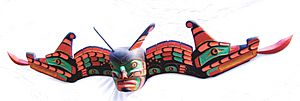Sisiutl facts for kids
The Sisiutl is a powerful and mysterious creature from the stories of the Indigenous peoples of the Pacific Northwest Coast. It's especially important to the Kwakwakaʼwakw people. Imagine a giant, two-headed sea serpent! Sometimes, this amazing creature is also shown with a special face in the middle, like a supernatural being. The Sisiutl appears a lot in the art, dances, and songs of these cultures. It's often linked to shamans, who are spiritual leaders, because both are seen as connecting the normal world with the spirit world.
Contents
What Does the Sisiutl Look Like?
The Sisiutl is usually shown as a serpent with two heads. But sometimes, it might have only one head. In art from the Kwakwaka'wakw people, you often see a human-like face right in the middle, between the two serpent heads. All three heads usually have horns. The serpent heads often have long tongues sticking out and noses that curl up or look like spirals. You might also see crescent shapes along its body.
Special Features of the Sisiutl
In Pacific Northwest cultures, horns or plumes (like feathers) on a creature usually mean it's a supernatural being. The spiral nose, or "inflated nostrils," is a special design seen on some masks. It can show that a creature is very hungry. A tongue sticking out is often linked to lightning, powerful magic, and the idea of power being passed from an animal to a person learning to be a shaman. The crescent shapes might look like scales or parts of a caterpillar's body.
Different Sisiutl Designs
Not all Sisiutl designs are exactly the same. Other groups, like the Tlingit people, have their own versions. For example, their "grubworm" or "woodworm" version is a bit different. It doesn't have the central human-like face and is known for being super hungry!
When a central human-like face is shown, it's often thought to be Baxbaxwalanuksiwe, a powerful spirit. It has also been linked to Qomoqua, another important spirit. In the northern "grubworm" story, the central head is believed to be a princess who cared for the grubworm. The Sisiutl can also change its shape. In one story, it turns into a canoe to help a woman return home from a spirit world. It can even appear as a squirrel!
Sisiutl in Indigenous Traditions
Shamans from different Indigenous tribes believed that if they could "kill" the Sisiutl in a spiritual way, its healing magic would transfer to them. Warriors also believed that the Sisiutl's blood would make them unbeatable in battle. Because of this, they often wore clothing or items with Sisiutl images for magical protection.
Similar Sisiutl designs were painted on canoes or carved into the wooden entrances of homes. This was done to keep away bad spirits and bring good luck. For some tribes, a shiny mineral found on beaches called mica was believed to be the Sisiutl's scales. They would use this mica in their traditions, believing it held the creature's power.
See also


